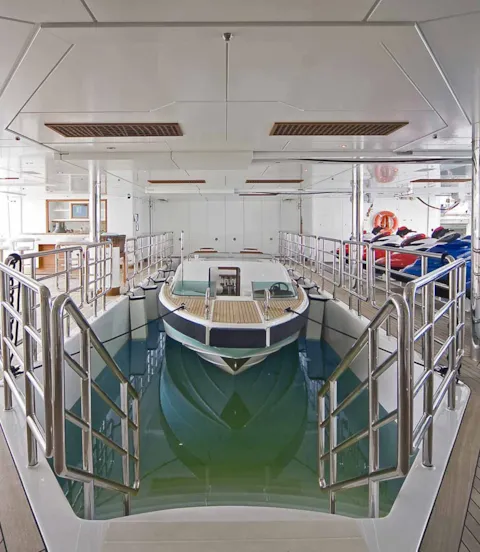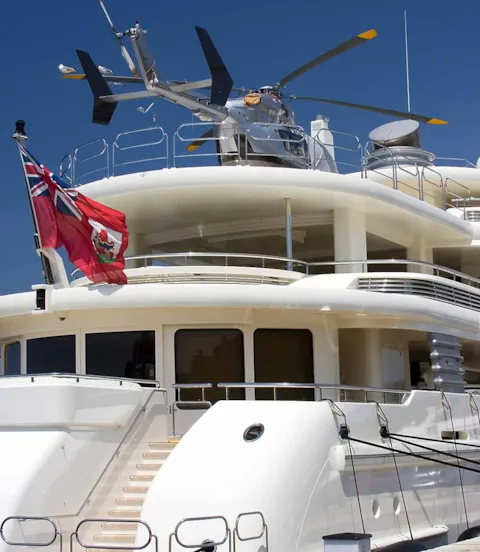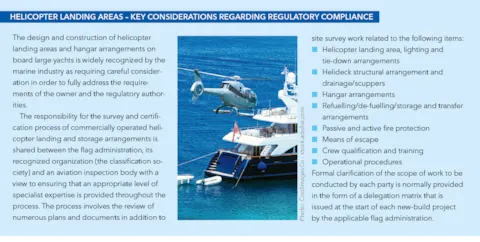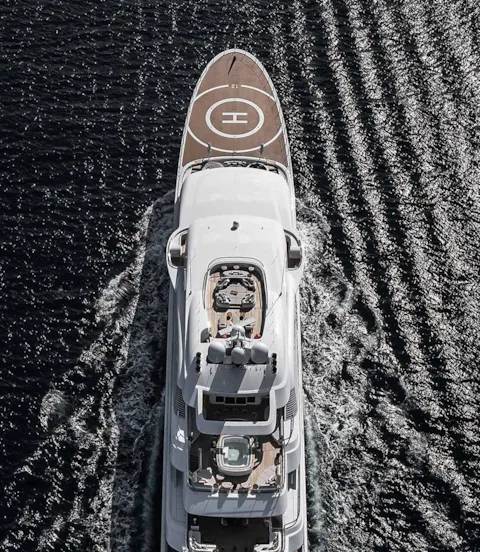How to launch and land it
Helipads, hangars, garages and moon pools have evolved with the superyacht industry over the past three decades. Reducing the relative motion between a craft and its mother ship, together with operational experience, is the key to successful operation. DNV GL partners with shipyards and designers to enable approval of complex designs.
Images of fashion models stepping aboard superyachts from racy tenders in idyllic conditions are ubiquitous in brochures, smiling crew standing attentively with welcome cocktails on the dry teak boarding platform. But the weather often changes fast. A swell building up in the anchorage off Monaco or a mistral off Saint-Tropez can make embarkation a bit more exciting than anticipated, with guests having to jump the gap between the tender and a wet platform into the arms of a crew member who suggests that they head straight up to the aft deck before getting their feet wet.

Water "toys" and tenders
Occasionally the embarkation location may be changed, especially if guests are frail, and the mother ship is brought into the calm of the port or a more protected bay. Nobody has yet designed a practical floating breakwater to form an artificial harbour – a mini version of the Mulberry harbour would probably take too long to rig – although drive-in tender garages offer a cocoon of sorts.
Where you put a tender garage is a decision to take during the design process. Options for the hatch include the side, in the transom or even under the hull in the case of a catamaran (with “bomb bay” doors opening on one VPLP design). Espen Øino has designed drive-in tender docks aboard a number of superyachts of over 100 metres in length. “It’s something which, if you drain the dock and wait before guests get off the boat, means obviously there is no more relative motion,” he points out. “Then you are sitting on chocks, but that takes time. The next best thing is to drive the boat in and close your transom door; there is much less wave action inside. But there is a critical moment as you drive in – if there is a lot of swell!”

All systems have limits
One repercussion of a drive-in transom hatch is that the draught of the transom needs to be quite deep for the dock to be useful. You need a margin in addition to the tender’s draught so you have to compromise on the draught of the aft ship and transom of the mother ship, which is critical for good performance. Øino adds: “For a displacement vessel you don’t want to have a big draught at the transom.” The knock-on effect extends to propulsion and steering-gear positioning.
Øino notes: “It is always a challenge to launch and retrieve any kind of tender, especially an AUV (autonomous underwater vehicle) – like the one we put on our first large explorer yacht and are putting on the REV. AUVs carry sonars, have no umbilical and are programmed to map the seabed and come up to a predefined point – you pick it up, take out the data and deploy it again. An ROV (remotely operated vehicle) normally has an umbilical but you still have to lift it in and out, so remotely operated releasing and pick-up hooks are an important detail.
Submarines and tenders are the same. It’s all a question of the relative motion between the object you are trying to launch and the mother ship. This is a function of the conditions in which you are trying to operate. It doesn’t matter what kind of system you have in place, at some point in time you will reach its limits.”
Øino points to one of Jon Bannenberg’s last designs, moored stern-to, right outside his design studio: “The tender and crane are on the main deck which – compared to yachts where tenders are stored below the main deck – has great merits because you don’t have the issue that the freeboard might have to be increased in order to enable tender launching, meaning a higher boat and thus an increase in beam and in turn of gross tonnage. With main deck cranes, you don’t open anything below the bulkhead deck. You’re always on the weather deck and the cranes are much higher up. But when the cranes come out laterally below the bulkhead deck, in a heavy sea, the tender could be squashed by the cranes. It’s all about priorities – launching tenders in a few minutes versus hours or days spent on an uncluttered aft deck under way.” Preferences need to be set at the outset when producing the design brief. The DNV GL-classed REV offers an array of options, from a moon pool to over-side launching.

Considering relative motion
Øino points out that “with a moon pool, you have hatches at deck level and at the bottom. The whole idea is that your water surface within the moon pool is much calmer than that of the outside seas; you contain the waves and therefore your operating window is increased. In addition, for a vessel like the REV, which is designed to operate in harsh conditions including Arctic and Antarctic climates, you also do all this from inside – so you are protected from the elements in the ship when it might be minus 25 degrees outside with wind – a much better working environment.”
DNV GL’s ship type expert for yachts, Martin Richter, agrees with Øino that “the relative motion between the tender and mother ship is a key element. It can be controlled to a certain extent by using your thrusters to create a lee, for example. Typically ships will head with the bow into the swell, as the wind direction and swell are often the same, so the most used area of superyachts for embarking and disembarking is the stern, because there is less movement than on the sides. Today, most larger yachts have a simplified dynamic-positioning (DP) system so they can swing the stern to cause a lee on one side. These are some operational measures to create a calmer area aft or amidships. In general, ships have better longitudinal stability than transverse stability, so, in this respect, launching big, heavy tenders over the transom would obviously be the favourable option.”
Details should all be given due consideration – single-point lifting is not as safe as two-point lifting: once the craft starts moving, it can be hard to control. Remote releasing and attachment are good, since a big hook could hit a crew member’s head. Whether the owner opts for a more efficient mother ship hull or a beach club and expansive deck space, or a more comfortable embarkation system, these are all factors that naval architects and designers need to take into account. DNV GL experts can act as “enablers” in complex launch, retrieval and storage situations – the REV being just one example.

Seaplanes and helicopters
Helicopters are far more popular aboard superyachts than seaplanes, having a bigger operational weather window. Of the few seaplanes seen on yachts, one was incorporated from the outset on a 74-metre motor yacht designed 30 years ago by Martin Francis to carry a Maule seaplane, which has since been removed. It was launched with a cross-beam, stowed on the overhang of the deck above, and lifted over the stern by arms emerging out of the bulwarks. Francis’ next seaplane-carrying vessel – a shadow boat – was “equipped with a transom lift that could accommodate anything from the owner’s sports fisherman to a Cessna Caravan floatplane – flexibility was key in the choice of a lift, still to my knowledge the only one. It proved more versatile than the cross-beam system,” says Francis.
There are three additional options for guests embarking from an aircraft other than on the superyacht itself: landing on the sea, on land or on a shadow vessel. Francis favours landing aircraft away from the main superyacht, either on the sea or on a shadow boat.
Busy harbours for superyachts no longer support seaplane landings. In their heyday, a century ago, Port Hercules in Monaco hosted a seaplane race stopover while Port Vauban in Antibes was used to land and house seaplanes long before the construction of the IYCA Billionaire’s Quay. Seaplanes are also used by a number of superyacht owners to ferry guests to their private islands.
There are more options for helicopters dropping off and picking up guests on the yacht’s helideck, which has the advantage of avoiding further transfers between vessels. A 15-year-old, 54-metre sloop designed by Ed Dubois is one of the very few sailing yachts with the ability to land an eight-seater helicopter – once the backstay and main boom have been moved forward. This is probably one of the most extreme “touch-and-go” areas that might be used to evacuate a guest in an emergency.
Motor yachts frequently have commonly called “touch-and-go” helidecks which are not certified, often on the foredeck, for the same purpose. A fully approved flight deck requires much more space and rigorous safety compliance and, if the helicopter is to be stowed aboard, hangars offer the best protection from the elements in transit.


The benefits of helicopters
Øino believes “a helicopter is a great thing to have on a yacht, with or without a hangar. It depends what you are doing and where you are going. If you cross the Atlantic with your helicopter aboard, then it is good to have a hangar! A helicopter needs to be looked after and, obviously, safety is closely linked to how it is maintained. There are many ways of looking after a helicopter and it doesn’t necessarily mean you have to include a hangar, as long as it is washed down regularly. Øino again emphasizes how owners should decide what their priorities are at the outset when making the design brief: “On a 126-metre research vessel we designed two decades ago, helicopters were an important part of the brief and the hangar drove the whole design of the yacht. On the REV, having two helicopters and pads means you can be your own rescuer. There is no rescue service in remote places such as polar waters, so if one helicopter comes down, you can take off with the other and go to the rescue.”
DNV GL offers shipyards and designers a service using its experts in the fields of structure, active fire protection, piping systems, electrical systems including explosion protection, and passive fire protection including escape routes. Once the arrangement, from overall geometry to landing lights, has been drafted, it is also inspected by an “aviation inspection body” (AIB). Requirements differ for helicopter operations aboard commercial versus private yachts but the responsibility and final decision on whether to land on the helideck rests with the pilot once the captain has given the OK.
- Key image - Areti_Lürssen
- Left side 2 - Espen Øino
- Left side 3 - ©Wildcat - stock.adobe.com
- Text image 5 - ©CoolimagesCo - stock.adobe.com
